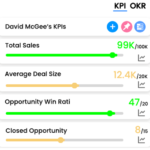Key Performance Indicators Examples

System Usability Scale
The System Usability Scale (SUS) is a standardized measure of perceived usability, which is used to evaluate the user experience of a website, application, or system. The SUS is a ten-item questionnaire that asks users to rate their level of agreement with a set of statements about the system’s usability. The questions are designed to measure the users’ overall satisfaction with the system, as well as specific aspects of the system’s usability such as learnability, efficiency, memorability, errors and satisfaction.
The SUS questionnaire consists of the following ten statements, each rated on a 5-point Likert scale (strongly disagree, disagree, neutral, agree, strongly agree):
- I think that I would like to use this system frequently.
- I found the system unnecessarily complex.
- I thought the system was easy to use.
- I think that I would need the support of a technical person to be able to use this system.
- I found the various functions in this system were well integrated.
- I thought there was too much inconsistency in this system.
- I would imagine that most people would learn to use this system very quickly.
- I found the system very cumbersome to use.
- I felt very confident using the system.
- I needed to learn a lot of things before I could get going with this system.
The scores for each statement are then combined to create an overall SUS score, which ranges from 0 to 100. A higher SUS score indicates a more usable system, with a score of 68 or above considered to be “acceptable” usability. The SUS is a widely used and accepted measure of usability, as it is quick and easy to administer and score, and has been shown to have good reliability and validity.
It’s important to note that the SUS is not a diagnostic tool, it’s a measure of perceived usability, it can give an overall view of how users perceived the usability of the system but it doesn’t provide specific information of where the problems are. Therefore, it’s recommended to use the SUS in conjunction with other usability methods like user testing, interviews, and surveys to get a more comprehensive picture of the user’s experience.
Measure what matters for your business with KPIs
Track business performance with real time key metrics against targets in one place without the need for multiple dashboards or reports
